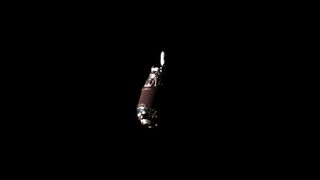
ADRAS-J, a satellite operated by the Japanese company Astroscale, captured this up-close photo of its rendezvous target, the spent upper stage of a Japanese H-2A rocket, in Earth orbit. Astroscale released the image on April 26, 2024.
(Image credit: Astroscale)
Space junk just got an epic close-up.
The ADRAS-J satellite, operated by the Japanese company Astroscale, successfully maneuvered to within a few hundred meters of a discarded rocket body this month, snapping a striking photo to memorialize the achievement.
“Behold, the world’s first image of space debris captured through rendezvous and proximity operations during our ADRAS-J mission,” Astroscale said today (April 26) in a post on X that shared the photo.
Related: Kessler Syndrome and the space debris problem
ADRAS-J (short for “Active Debris Removal by Astroscale-Japan”) launched to Earth orbit atop a Rocket Lab Electron vehicle on Feb. 18.
The 330-pound (150 kilograms) probe’s main task is to rendezvous with, and study, a big hunk of space junk — the upper stage of the Japanese H-2A rocket that launched the GOSAT Earth-observation satellite in 2009. Such work will help prove out technologies that future spacecraft can use to service satellites or capture and de-orbit debris objects, according to Astroscale.
Earlier this month, ADRAS-J got within a few hundred kilometers of the rocket body, which is about 36 feet long by 13 feet wide (11 by 4 meters). The probe then shifted into “proximity approach phase,” conducting multiple maneuvers that reduced the distance to just a few hundred meters — a milestone that the newly released photo preserves for posterity.
Breaking space news, the latest updates on rocket launches, skywatching events and more!
And more imagery is likely coming soon as well.
“In the next phase of the mission, ADRAS-J will attempt to capture additional images of the upper stage through various controlled close-approach operations,” Astroscale wrote in an update today. “The images and data collected are expected to be crucial in better understanding the debris and providing critical information for future removal efforts.”
Removal of the biggest, most dangerous debris objects may be necessary to keep Earth orbit safe and accessible, many exploration advocates say. Rocket bodies like the H-2A upper stage are like giant bullets whizzing around Earth; if they slam into another hunk of junk or an active satellite, the smashup could spawn a debris cloud that could lead to a catastrophic collision cascade.
The newly released ADRAS-J photo is not the first up-close view of space junk that we’ve ever seen, as spaceflight historian Gunther Krebs noted.
In 2003, the U.S. Air Force Research Laboratory’s XSS-10 satellite met up with the spent upper stage of a Delta II rocket and snapped an image of the object. However, this was a less complex task than the one ADRAS-J just achieved; XSS-10 had launched aboard that same Delta II.
Join our Space Forums to keep talking space on the latest missions, night sky and more! And if you have a news tip, correction or comment, let us know at: community@space.com.
Michael Wall is a Senior Space Writer with Space.com and joined the team in 2010. He primarily covers exoplanets, spaceflight and military space, but has been known to dabble in the space art beat. His book about the search for alien life, “Out There,” was published on Nov. 13, 2018. Before becoming a science writer, Michael worked as a herpetologist and wildlife biologist. He has a Ph.D. in evolutionary biology from the University of Sydney, Australia, a bachelor’s degree from the University of Arizona, and a graduate certificate in science writing from the University of California, Santa Cruz. To find out what his latest project is, you can follow Michael on Twitter.
>>> Read full article>>>
Copyright for syndicated content belongs to the linked Source : Space.com – https://www.space.com/astroscale-adras-j-space-junk-rendezvous-mission-photo
